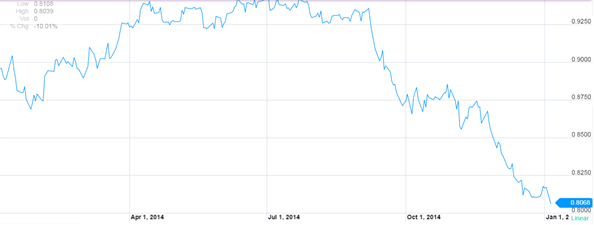2015 – Is the Aussie Dollar Going Down ?
Currencies / Austrailia Jan 06, 2015 - 12:32 PM GMTBy: Submissions
Badre Bouarich writes: At a time where oil prices are hitting the ground driven by a high supply - low demand environment, several market actors are getting to expect a depreciation of the so called commodity currencies. As defined by the financial dictionary ( ) and studied by IMF Senior Economists ( ), commodity currencies are currencies whose exchange rate is highly correlated to the price of a commodity.
While the Aussie lost more than 9% of its value towards the US Dollar in 2014, the Kiwi mitigated the losses to around 6% ( ). Surprisingly, the move has driven optimism from local financial authorities as Glenn Stevens, the Governor of the Reserve Bank of Australia said that the Australian Dollar should probably be closer to 75 cents against the US Dollar, down from its current level of $0,81 – which arguably would boost the Australian economy’s competitiveness.
Indeed, as the US economy has been showing better numbers in 2014, the US consumer number has has recently sent positive sentiments. On its recent release, its figure has gone up to 92.6 points, up from 88.8 points a month earlier. On the Aussie side, lower commodity prices including oil, iron and coal combined to a central bank willingness to get a weaker AUD are likely to lead to a fall of the AUDUSD pair in the first half of 2015.
Taking into account such macro-economic environment, it is time for reluctant investors and expats out there to exchange their savings into USD. In fact, a look at the currency pairs’ trend shows a clear bearish path.

Technical & fundamental analysis joins Glenn Stevens’ remarks and shows that a level of at least 0.75 is to be targeted. Now this can also be seen as a downside potential of 7.5% to be accomplished within a quarter.
This being said, targets and profits can be jeopardized in case the wrong money exchange house is used. Indeed, as several banks would quote prices in different currencies (HSBC, Barclays, Natwest), the spread they offer can be quite wide at times. For this reason, it might be worth it for individuals willing to exchange currencies to use a money transfer house and follow the advices of moneytransfercomparison.com. Actually, some houses are able to make the quotes tighter by up to 5% compared to banks ( ) – which can enable one to fully capture the AUDUSD pairs’ bearish momentum.
Beyond these considerations, history shows that moves can sometimes be even stronger than expected. Hence based on Australia’s economic performance in Q1 2015 and worldwide commodity prices (mainly oil), one would be able to set a middle term target leading to H1 2015. As most of the past pair moves were tied to the US economy’s performance, it seems logical that future impacts will be mainly driven by news coming from the Kangaroo’s country.
Writen by Badre Bouarich
Badre Bouarich is a former trader and multi asset structurer at HSBC. He used to structure derivatives solutions from the London and Dubai offices and covered both institutional and corporate spheres. He is also financial writer and contributes in several finance related blogs and websites. He holds an Msc in Finance from IE Business School in Madrid.
© 2014 Copyright Badre Bouarich - All Rights Reserved Disclaimer: The above is a matter of opinion provided for general information purposes only and is not intended as investment advice. Information and analysis above are derived from sources and utilising methods believed to be reliable, but we cannot accept responsibility for any losses you may incur as a result of this analysis. Individuals should consult with their personal financial advisors.
© 2005-2022 http://www.MarketOracle.co.uk - The Market Oracle is a FREE Daily Financial Markets Analysis & Forecasting online publication.



